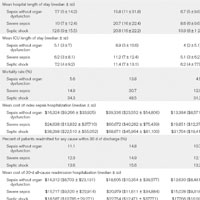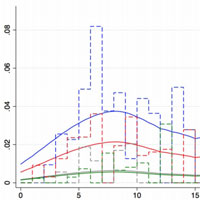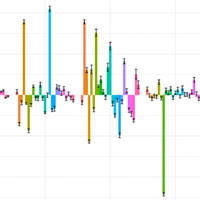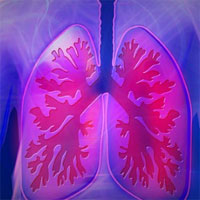Tag: LOS

Epidemiology and Costs of Sepsis in the United States
The highest burden of incidence and total costs occurred in the lowest severity sepsis cohort population. Sepsis cases not diagnosed until after admission, and those with increasing severity had a higher economic burden and... read more

Impact of a Multifaceted Prevention Program on VAP Including Selective Oropharyngeal Decontamination
Ventilator-associated pneumonia (VAP) remains a serious complication of mechanical ventilation (MV), and has an incidence between 2 and 16 episodes per 1000 ventilator-days, an attributable mortality of 5–13%, excess ICU... read more

Ineffectiveness of Procalcitonin-Guided Antibiotic Therapy in Severely Critically Ill Patients
Procalcitonin-guided (PCT) antibiotic therapy fails to decrease the mortality or length of stay (LOS) of critically ill patients with suspected or confirmed sepsis. PCT-guided cessation of antibiotic therapy could reduce... read more

Identification of Subclasses of Sepsis that Showed Different Clinical Outcomes and Responses to Amount of Fluid Resuscitation
Sepsis is a heterogeneous disease and identification of its subclasses may facilitate and optimize clinical management. This study aimed to identify subclasses of sepsis and its responses to different amounts of fluid resuscitation.... read more

Impact on Patient Outcomes of Pharmacist Participation in Multidisciplinary Critical Care Teams
Including critical care pharmacists in the multidisciplinary ICU team improved patient outcomes including mortality, ICU length of stay in mixed ICUs, and preventable/non-preventable adverse drug events. From the 4,725... read more

Long-term Health Consequences of Under- and Over-feeding in PICU
Energy is essential for the treatment and recovery of children admitted to Pediatric Intensive Care Units (PICU). There are significant immediate and long-term health consequences of both under- and over-feeding in this population.... read more

PERFECT Protocol: Volume-based Feeding in Ventilated Adults
Underfeeding in critical illness is common and associated with poor outcomes. Researchers in the UK designed a before-and-after study to evaluate the safety, efficacy and clinical outcomes associated with volume-based feeding... read more

Reducing Emergency Department Length of Stay
An interdisciplinary team of front-line physicians, nurses, medical assistants, and executives assembled and used value stream mapping to assess the entire ED care process, from patient arrival to admission or discharge.... read more

ECMO Use in Cardiogenic Shock
Increasing age is a well-recognized risk factor for in-hospital mortality in patients receiving extracorporeal membrane oxygenation (ECMO) for cardiogenic shock, but the shape of this relationship is unknown. Age is linearly... read more

Does De-escalation of Anti-MRSA Therapy for Culture-negative Pneumonia Affect Patient Outcomes?
Nosocomial pneumonia is a common hospital-acquired infection and has a high mortality rate in the critically ill. Because drug-resistant bacteria like Pseudomonas aeruginosa and methicillin-resistant Staphylococcus aureus... read more

The CAM-ICU-7 Delirium Severity Scale: A Novel Delirium Severity Instrument for Use in the ICU
The CAM-ICU-7 delirium severity scale is a valid, reliable, and practical delirium severity measure among ICU patients that can be easily calculated and is associated with meaningful clinical outcomes. This practical tool... read more

Effect of a Resuscitation Strategy Targeting Peripheral Perfusion Status vs Serum Lactate Levels on 28-Day Mortality Among Patients With Septic Shock
Among patients with septic shock, a resuscitation strategy targeting normalization of capillary refill time, compared with a strategy targeting serum lactate levels, did not reduce all-cause 28-day mortality. Among 424 patients... read more

The Clinical Impacts and Risk Factors for Non-central Line-associated Bloodstream Infection in 5046 ICU Patients
Most of the previous studies focused on central line-associated bloodstream infection (CLABSI), while non-central line-associated bloodstream infection (N-CLABSI) was poorly studied. This study was performed to investigate... read more

Effect of Cricoid Pressure Compared With a Sham Procedure in the Rapid Sequence Induction of Anesthesia
This large randomized clinical trial performed in patients undergoing anesthesia with RSI failed to demonstrate the noninferiority of the sham procedure in preventing pulmonary aspiration. Further studies are required in... read more




